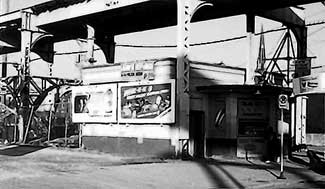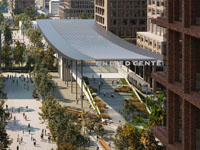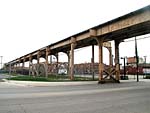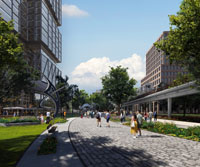|
|
|
|
 |
Housing a hot dog stand at the end of its life, the former Madison station house was demolished in the 1990s in spite of being assigned the second-highest rating of importance in the Chicago Historic Resources Survey. (Chicago Tribune file photo) |
|
|
|
|
 |
Housing a hot dog stand at the end of its life, the former Madison station house was demolished in the 1990s in spite of being assigned the second-highest rating of importance in the Chicago Historic Resources Survey. (Chicago Tribune file photo) |
Madison
(1700W/1N-S)
Madison Street and Paulina
Street, Near West Side
Service Notes:
Logan Square Line
Quick Facts:
Address: 1718 W. Madison Street
Established: May 6, 1895
Original Line: Metropolitan West Side Elevated, Northwest branch
Previous Names: n/a
Skip-Stop Type: n/a
Rebuilt: n/a
Status: Demolished
History:
The Met station house at Madison, built in 1895 as part of the original section of the Metropolitan "L"'s Northwest route, was nearly identical all the other stations on the branch. The station house was typical of Met designs on the Northwest and Garfield Park branches. Built by the Jonathan Clark & Sons Company for the general contractor, Alfred Walcott, the stations were designed by the engineering staff of the Metropolitan company. Constructed of red pressed brick with stone sills and foundations, their vernacular style might best be described as Queen Anne-influenced with some Romanesque features. The station's design was highlighted by the semicircular bay/portico, a lattice pattern in the brick cornice, extensive terra cotta work including the word "entrance" above one door in the portico and "exit" above the other (although there was nothing to force ingress from one and egress from the other), dentals above the doors' story lights, and carved wooden beads flush with the building between the wooden brackets which supported a wooden canopy over the portico.
The station had dual side platforms, with canopies and railings typical of all Met stations: Designed into the railings were larger cast iron square plates with a stylized diamond design. The stairs and platforms were constructed of wood on a steel structure. Each platform had a short canopy in the center of the platform, covering the stairs and a small waiting area. The canopy frame was iron, with arched latticed supports and bracketed rafters, and hipped roofs of corrugated tin.
Madison station served the adjacent Chicago Stadium, a famous and beloved local arena where sporting events and other spectacles such as circuses and political conventions were held. Known as "the Madhouse on Madison" for its earsplitting interior, Chicago Stadium was an Art Deco gem that sported relief sculptures of athletes -- shot-putters, discus throwers, sprinters, cyclists and boxers -- on its masonry façade. It has since been demolished and replaced by the United Center.
Madison was closed February 25, 1951 when the Logan Square branch of the former Metropolitan "L" was rerouted through the Milwaukee-Dearborn Subway. Douglas branch trains were routed to the old Logan Square tracks and onto the Lake Street "L" in 1954 while the Congress line was being built, but the station was not reactivated. The platforms and canopies were removed, but the station house remained, converted into a commercial building.
From 1983 to 1995, the City of Chicago compiled the Chicago Historic Resources Survey, which identified 17,371 properties as potential landmarks and rated them by color code according to their architectural or historical value. In spite of this effort at identification of significant structures, hundreds of these buildings were torn down in the late 20th and early 21st century. In the survey, the Madison station house was listed as an Orange-rated structure, defined as those buildings significant in the context of their communities. In later years, the former station house housed a hot dog stand. However, in spite of being assigned the second-highest rating of importance in the Chicago Historic Resources Survey, the former Madison headhouse was demolished circa the late 1990s.
Brief discussions were held in 1996 about bringing the Madison stop back for the Democratic National Convention at the United Center, but it never came to pass.1
In Spring 2012, the Bulls organization discussed a desire to build a $95 million retail and entertainment complex on the east side of the United Center. The 263,000-square-foot retail-and-entertainment center would add four restaurants, four bars, a team store, an event space, team offices, parking, a terrace, an atrium and a green roof. The complex would include building an atrium over the statue of Michael Jordan. Howard Pizer, executive vice-president of the Bulls, said in November 2012 that construction of the retail and entertainment complex would be contingent on nailing down an updated version of the property tax formula that has saved the Bulls and Hawks millions on property tax bills assessed against the United Center.2 Mayor Rahm Emanuel acknowledged the possibility of creating a new CTA stop that would serve both the United Center as well as a new Malcolm X College he plans to build adjacent to the old one now located east of the United Center.3 The CTA had no plans to build another stop at Madison as of November 2012, according to the agency, though they said it could become part of future proposals.4
In July 2024, the owners of the United Center released a $7 billion plan, called the 1901 Project, to develop the Near West Side neighborhood around the stadium. The 1901 Project, which is named for the United Center's street address (1901 W. Madison St.), was sold as a transformational multi-billion-dollar neighborhood investment that would change the face of the entire area surrounding the arena.
Envisioned as a 10-year, multi-phase plan, the goal of the project was create a year-round 55 acre retail and entertainment district and would create revenue opportunities for the teams in much the same way that the redevelopment of Wrigley Field's surroundings did -- beginning in the 2010s, the Ricketts family, owners of Chicago Cub's ballpark, turned empty lots next to and across Clark Street from the stadium into a hotel, a public plaza, new offices and retail, among other improvements. The Reinsorf and Wirtz families, which jointly own the 30-year-old United Center, said their new plan would be more than a sports-focused district; it is envisioned as a new neighborhood with the United Center as its anchor.5 6

Detail view of a rendering released by the 1901 Project depicting a Pink Line station at Madison serving the development. The depiction of the station should probably be taken as purely conceptual, however, given that it only shows one track and a single New York subway-style car -- its purpose is more to convey a general idea of what a station could be rather than any specific layout or architectural design. For a larger view, click here [off-site link]. (Rendering courtesy of 1901 Project) |
The new campus proposal, which is similar in size and planned square footage to the Lincoln Yards and 78 megaprojects, comes as the development gap between downtown and the United Center has been closing with new apartment buildings and other projects in the western portion of the trendy Fulton Market District and West Loop. The focal point of the 1901 Project's first phase will be a theater-style music hall on a parcel at the northeast corner of Damen Avenue and Adams Street and an elevated 2.5-acre park along the western edge of the arena built atop a new structure that includes parking, an expanded loading dock and outward-facing retail. Future phases of the development include even more ambitious buildings. Residential buildings and park space are envisioned on lots north of the stadium near the Westhaven Park Apartments and higher density residential buildings northeast of the arena. United Center executives said the entire megaproject could include between 5,000 and 6,000 new residential units, and that 20% of them will be designated affordable units.7
Michael Reinsorf, president and CEO of the Chicago Bulls, and Danny Wirtz, President and CEO of the Chicago Blackhawks, said they are committed to covering the entire $7 billion price tag with private funds. United Center CEO Terry Savarise said although the development will predominantly use private funds, the developers will explore the possibility of tapping into a neighboring tax increment financing district.8
A new Pink Line station at Madison is included in the plan, but not as part of the improvements the developers would pay for. The developers stated they want to see a new Pink Line station serve the new district, but it would have to be funded by the city, possibly with TIF funds. 27th Ward Alderman Walter Burnett expressed support for the idea, saying, "If we can get more people to get on the Pink Line to come here CTA will make more money so it's a win-win for CTA. It's a win-win for the city."9
While largely supportive of the project, Burnett, who is also the City Council's Zoning Committee chair, expressed some reservations about how the Pink Line station the developers included in their plan would be paid for. "They say they're not using any government money," Burnett said in September 2024. "But they're not using any government money for their private property at the same time they may be inquiring about public property where we put in some money."10
While a likely funding source for funding the station would be the surrounding Central West TIF District, that district is set to expire in 2024. (Whether the station would be within the district's boundaries also depends precisely where along the Pink Line tracks it is built, as the district's border weaves between each side of the tracks between Warren and Adams.) "The concern is, they want to use TIF money," Burnett said. "Do we have the money? If the TIF expires, then what do we have? The only way we would be able to do it is if we extend the TIF." He continued, "it would be great and beneficial to have a Pink Line [station]. But how do you pay for it?... It's not easy to just say, 'You should put an L stop there.' Where's the increment going to come from?"11
United Center officials said in July 2024 they've had initial conversations with CTA leadership about a new Madison Pink Line station, but provided no details.12
Much of the development would be build on a sea of surface parking lots that currently surround the United Center (and are owned by the teams' owners), and the new development would include parking garages to replace the lost surface parking. But, the developers and planning consultants for the project see the addition of a Pink Line station at Madison as a key way to diversify transportation options and reduce the number of parking spaces that would need to be provided in the replacement garages.13
All plans depend on approval from city council. If given the green light, groundbreaking for the development could begin as soon as spring 2025.14 When work on the station would begin is not clear.
 |
ROW@Madison02.jpg (155k) The former location of Madison station on the Met's Northwest branch -- now the "Paulina Connector" -- is still evident by a few features visible in this April 2003 view looking northeast. Among them are the remnants of the horizontal steel platform supports protruding from the elevated structure, now truncated but still in evidence, and the unusual arched lattice support frame under the elevated structure that was once in the rear of the station house (visible in the view at the top of the page). (Photo by Graham Garfield) |
 |
The1901Project_Render_7.jpeg [off-site link] A rendering released by the 1901 Project showing the Pink Line elevated running alongside the proposed new development. The depiction of the "L" is merely conceptual, however -- note that it is a single track, not two, and the style of the elevated track structure is very different from what is currently there; the single rapid transit car shown is also a New York subway car, not an "L" car. (Rendering courtesy of the 1901 Project) |
|
1. Hilkevitch, Jon. "Getting Around: Answering questions about CTA construction and idling buses." Chicago Tribune, November 19, 2012.
2. Spielman, Fran. "Bulls: New practice facility a go, but entertainment complex needs a tax break." Chicago Sun-Times, November 16, 2012.
3. Ibid.
4. Hilkevitch, ibid.
5. Gallardo, Michelle. "United Center owners pitch $7B investment called 1901 Project to revitalize neighborhood." ABC Chicago, July 23, 2024.
6. Rogal, Brian. "Reinsdorf and Wirtz families unveil $7 billion proposal to remake Near West Side around United Center." Chicago Tribune, July 23, 2024.
7. Ecker, Danny. "United Center owners plan $7 billion Near West Side campus." Crain's Chicago Business, July 23, 2024.
8. Rogal, ibid.
9. Gallardo, ibid.
10. Spielman, Fran. "United Center mega-project sounds enticing, Burnett says. But who'll pay for new Pink Line station?" Chicago Sun-Times, September 27, 2024.
11. Ibid.
12. Ecker, ibid.
13. Rogal, ibid.
14. Gallardo, ibid.